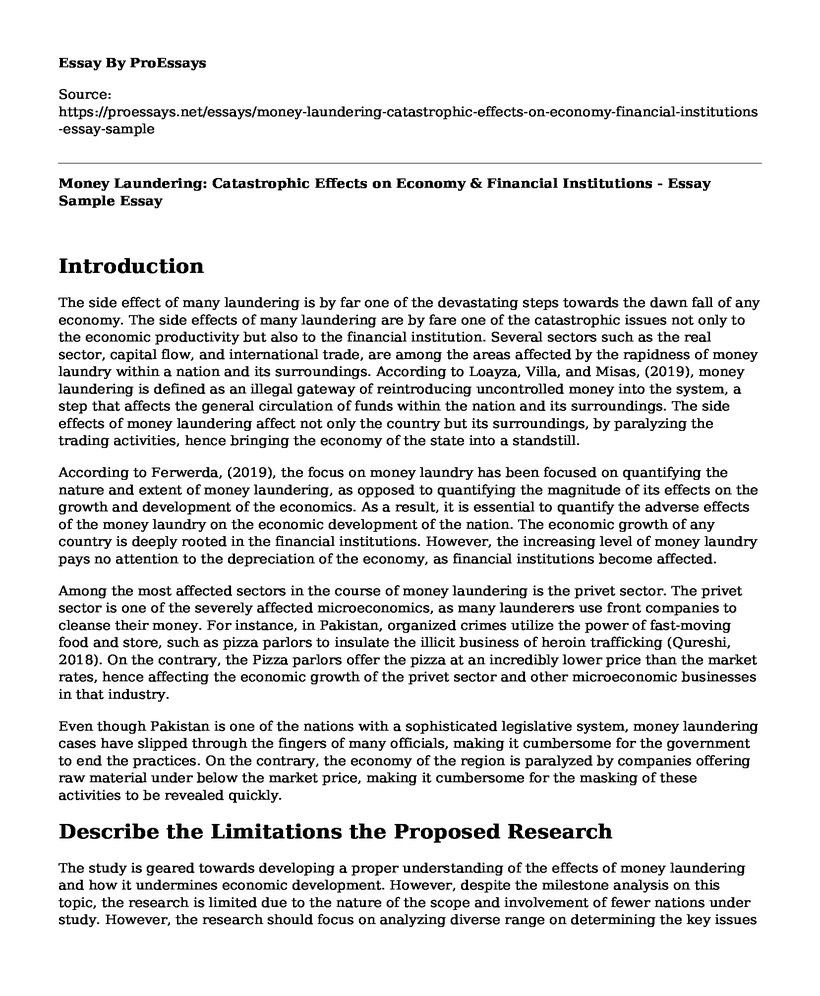Introduction
The side effect of many laundering is by far one of the devastating steps towards the dawn fall of any economy. The side effects of many laundering are by fare one of the catastrophic issues not only to the economic productivity but also to the financial institution. Several sectors such as the real sector, capital flow, and international trade, are among the areas affected by the rapidness of money laundry within a nation and its surroundings. According to Loayza, Villa, and Misas, (2019), money laundering is defined as an illegal gateway of reintroducing uncontrolled money into the system, a step that affects the general circulation of funds within the nation and its surroundings. The side effects of money laundering affect not only the country but its surroundings, by paralyzing the trading activities, hence bringing the economy of the state into a standstill.
According to Ferwerda, (2019), the focus on money laundry has been focused on quantifying the nature and extent of money laundering, as opposed to quantifying the magnitude of its effects on the growth and development of the economics. As a result, it is essential to quantify the adverse effects of the money laundry on the economic development of the nation. The economic growth of any country is deeply rooted in the financial institutions. However, the increasing level of money laundry pays no attention to the depreciation of the economy, as financial institutions become affected.
Among the most affected sectors in the course of money laundering is the privet sector. The privet sector is one of the severely affected microeconomics, as many launderers use front companies to cleanse their money. For instance, in Pakistan, organized crimes utilize the power of fast-moving food and store, such as pizza parlors to insulate the illicit business of heroin trafficking (Qureshi, 2018). On the contrary, the Pizza parlors offer the pizza at an incredibly lower price than the market rates, hence affecting the economic growth of the privet sector and other microeconomic businesses in that industry.
Even though Pakistan is one of the nations with a sophisticated legislative system, money laundering cases have slipped through the fingers of many officials, making it cumbersome for the government to end the practices. On the contrary, the economy of the region is paralyzed by companies offering raw material under below the market price, making it cumbersome for the masking of these activities to be revealed quickly.
Describe the Limitations the Proposed Research
The study is geared towards developing a proper understanding of the effects of money laundering and how it undermines economic development. However, despite the milestone analysis on this topic, the research is limited due to the nature of the scope and involvement of fewer nations under study. However, the research should focus on analyzing diverse range on determining the key issues that facilitate money laundering within the money circulation system.
The Essence of the Topic
Money laundering poses a significant threat to the economic development of a region. As a result, the danger of money laundry is widely associated with the devastating effects of undermining the economic development of a nation. In this case, the essence of this topic is geared towards illuminating the devastating effects the economy has to suffer under the york of money laundering.
The essence of this topic is to help gather essential data from reliable sources to increase the awareness of money laundry in different countries, and how these illegal activities are conducted under the nose of the government officials. On the contrary, the topic serves as a templet of developing and conducting research by offering different concepts to help collect data, such as getting first-hand data from the financial institutions of the sampled nations.
References
Ferwerda, J. (2019). Criminological perspectives on money laundering: the efficiency of anti-money laundering policies. In Research Handbook on Transnational Crime. Edward Elgar Publishing. doi.10.4337/9781784719449.00015
Loayza, N., Villa, E., & Misas, M. (2019). Illicit activity and money laundering from an economic growth perspective: A model and an application to Colombia. Journal of Economic Behavior & Organization, 159, 442-487.doi.10.1016/j.jebo.2017.10.002
Qureshi, W. A. (2018). An Overview of Money Laundering in Pakistan and Worldwide: Causes, Methods, and Socioeconomic Effects. University of Bologna Law Review, 2(2), 300-345.DOI: 10.6092/issn.2531-6133/7816
Cite this page
Money Laundering: Catastrophic Effects on Economy & Financial Institutions - Essay Sample. (2023, Apr 08). Retrieved from https://proessays.net/essays/money-laundering-catastrophic-effects-on-economy-financial-institutions-essay-sample
If you are the original author of this essay and no longer wish to have it published on the ProEssays website, please click below to request its removal:
- Starbucks Financial Statement Analysis
- Essay on Sales Taxation
- Outside Funding Essay Example
- Health Insurance Plans and Their Impact on the United States Essay Example
- Liability Risks Paper Example
- British Telecommunication Company BT Dividend Policy Paper Example
- Paper Example on Poor Communication in Banking: Impact on Employee Morale, Ethics, & Performance







